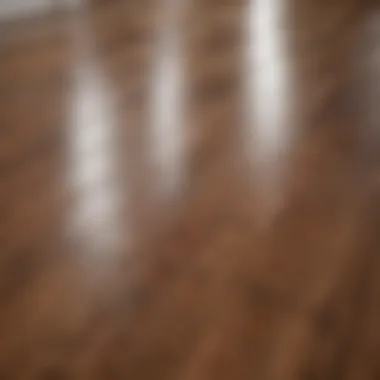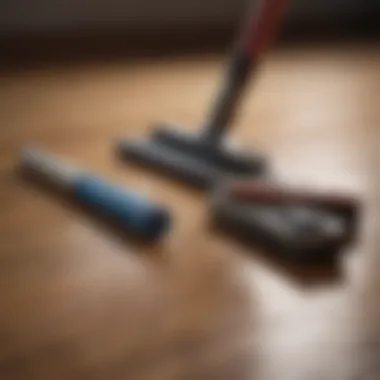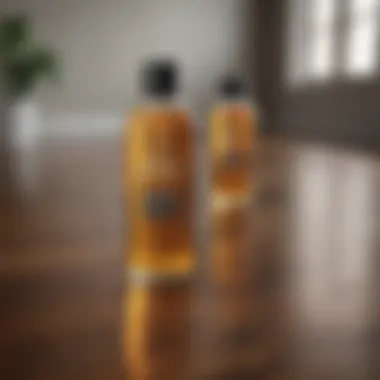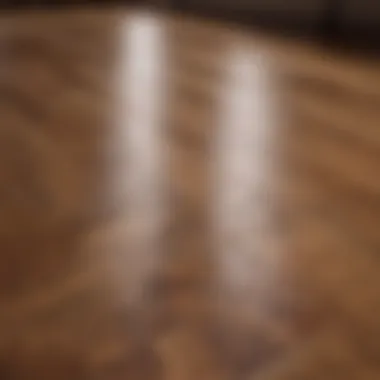Deep Cleaning Hardwood Floors: A Step-by-Step Guide


Intro
Deep cleaning hardwood floors by hand is more than just a simple chore; it's an essential practice that preserves the beauty and longevity of this exquisite material. Hardwood floors, with their unique charm and robustness, need meticulous care to maintain their shine and structural integrity. Here, we will elucidate the step-by-step process everyone can employ to achieve optimal cleanliness, along with tools and methods available to enhance the task.
Understanding the importance of deep cleaning is pivotal, as it affects not only the aesthetic quality but also indoor air purity. Dust, allergens, and grime accumulate in the hard-to-reach corners, making regular maintenance a necessity. Armed with the right knowledge and resources, anyone can turn cleaning into a systematic and satisfying process.
By the end of this guide, readers will be equipped to tackle stubborn dirt and restore their hardwood floors to their former glory.
Prelims
The upkeep of hardwood floors is a task that goes beyond mere surface cleaning. This article emphasizes why deep cleaning is crucial in maintaining not only the aesthetics but also the longevity of hardwood flooring. Over time, dirt, dust, and grit accumulate, creating an unsightly layer that can dull the shine and color of the wood. Such buildup can also scratch the surface, potentially leading to costly repairs or replacement.
Deep cleaning addresses these issues directly. It allows homeowners to restore the original luster of their floors, enhancing the beauty of the entire space. Regular maintenance is also important because neglected floors can become a breeding ground for allergens, impacting indoor air quality. Thus, deep cleaning hardwood floors is not just about visual appeal; it’s about the overall health of your home environment.
In addition, frequent deep cleaning can help preserve the protective finish of the wood. This ensures that the investment in hardwood flooring remains sound over time, offering both aesthetic and functional benefits. By understanding the right techniques and using the appropriate tools and solutions, homeowners can achieve results that reflect their commitment to cleanliness and care.
As we delve into this guide, readers will find detailed instructions, practical tips, and the essential knowledge needed to maintain the integrity and beauty of hardwood floors.
Understanding Hardwood Floors
Hardwood floors are a popular choice among homeowners, interior designers, and real estate enthusiasts. They bring an element of warmth and elegance to any space. Understanding hardwood floors is crucial for anyone looking to maintain their beauty and functionality over time. Knowing the types of hardwood floors and their characteristics can greatly influence your cleaning and maintenance strategies.
Types of Hardwood Floors
When it comes to hardwood floors, there are primarily two categories: solid hardwood and engineered hardwood.
- Solid hardwood is made from a single piece of wood. This type typically ranges from 3/4 inch thick. It can be sanded and refinished multiple times, which makes it a long-lasting option. However, it is sensitive to humidity and temperature changes, which can lead to warping.
- Engineered hardwood consists of several layers of wood veneer and plywood glued together. This construction makes it more stable in fluctuating environments. Although it cannot be sanded or refinished as many times as solid hardwood, it offers more versatility in placement.
Each type has its own unique properties and suitability depending on the location and the desired aesthetic. Understanding these differences helps homeowners make informed decisions regarding cleaning methods and upkeep.
Common Characteristics
Different hardwood floors share certain characteristics that are important to note. Generally, hardwood floors are known for their durability and aesthetic appeal. Key traits include:
- Grain Pattern: Each type of wood has distinct grain patterns which can affect the overall look of the floor.
- Color Variation: Depending on the wood species, colors may vary significantly. Some woods darken with age, affecting their appearance over time.
- Finish: The surface finish can either enhance or detract from the wood's natural beauty. It may also influence how easily stains and scuffs can be cleaned.
- Moisture Resistance: Some hardwood types have natural resistance to moisture, which is critical in certain environments. However, almost all hardwood will not fare well in excessively humid conditions.
Understanding these common characteristics not only helps in the selection of flooring but also facilitates better cleaning and maintenance choices. Depending on the specific type, homeowners can tailor their deep cleaning processes to ensure the longevity and aesthetic integrity of their hardwood floors.
"Choosing the right hardwood is not only about aesthetics but also suitability to your living environment."
Importance of Deep Cleaning
Deep cleaning hardwood floors is often overlooked in routine home maintenance yet holds significant importance. Neglecting this form of care can lead to both aesthetic and structural issues. Focusing on the importance of deep cleaning offers insights into the immediate benefits as well as long-term advantages for homeowners and enthusiasts alike.
Impact on Aesthetics
The appearance of hardwood floors can dramatically influence the overall look and feel of a space. When deep cleaning is performed regularly, it enhances the natural beauty of the wood, restoring its shine and vibrancy. Dust, grime, and stains tend to build up over time, dulling the finish and degrading its visual appeal. A thorough deep cleaning process removes these contaminants, making the floors look more inviting. This is particularly important in areas with high foot traffic, such as living rooms and hallways, where first impressions are often formed.
Regular maintenance through deep cleaning not only promotes beauty but also provides a clean environment. Pet hair, allergens, and dirt can contribute to an unhealthy atmosphere within the home. Ultimately, a clean floor elevates the overall aesthetic, making spaces feel fresher, brighter, and more inviting to guests.


Preserving Longevity
Deep cleaning is not just about superficial appearance; it is also crucial in preserving the longevity of hardwood flooring. Over time, residue from cleaning products, dirt, and moisture can seep into the wood, causing it to warp or lose its structural integrity. A regular deep cleaning regimen helps to eliminate harmful substances that could damage the finish and wood itself.
In addition, routine deep cleaning is essential for preventing scratches and scuffs. These imperfections can accumulate and lead to the need for costly refinishing. By maintaining a clean and well-cared-for floor, homeowners can avoid premature wear, ultimately extending the life of their investment.
"Regular deep cleaning protects not just the beauty of hardwood floors but also their longevity. Investing time in this process saves money in the long run."
In short, the impact of deep cleaning hardwood floors is far-reaching. It supports aesthetic appeal and contributes to the durability of the wood. Homeowners should prioritize this process to maintain their flooring effectively, ensuring both beauty and resilience.
Preparation for Cleaning
Preparation is a vital step in the process of deep cleaning hardwood floors by hand. Without proper preparation, you may overlook essential tasks or use the wrong tools, leading to less effective results. Taking the time to prepare ensures that you have everything you need before starting. This can save you time and prevent frustration during the cleaning process. Additionally, assessing the condition of your hardwood floor can inform you on specific cleaning needs or areas that require extra attention.
Gather Necessary Tools
Before diving into the cleaning process, it is crucial to gather all necessary tools. Having the right tools on hand allows for a more efficient and effective cleaning experience. Each tool serves a unique purpose and contributes to achieving clean and maintained floors.
Soft-bristle Broom
A soft-bristle broom is essential for sweeping hardwood floors. Its soft bristles are designed to trap dust and debris without scratching the surface of the wood. One of the key characteristics of a soft-bristle broom is its gentleness. This feature makes it a popular choice for maintaining hardwood floors. While it may not remove deep-seated dirt, it is effective in daily upkeep.
Mop and Bucket
The mop and bucket combination is a staple in floor cleaning. This tool is effective for applying cleaning solutions evenly across the floor. The key characteristic of this equipment is its versatility. Using a traditional mop and bucket allows you to control the amount of liquid disperses on the floor, which is crucial for hardwood surfaces. However, be cautious not to oversaturate the floor, as excess water can lead to damage over time.
Microfiber Cloths
Microfiber cloths have gained popularity in recent years for their high efficiency in cleaning. One specific aspect of microfiber cloths is their ability to attract and hold dust and dirt particles. This makes them a beneficial choice for not only cleaning but also for polishing hardwood floors. Their unique feature is the combination of softness and absorbency. They can easily lift dirt without scratching the floor, though it may require frequent washing to maintain their effectiveness.
Appropriate Cleaning Solutions
Using the right cleaning solutions is critical to maintaining your hardwood floors. Appropriate cleaning solutions are designed to break down dirt while preserving the wood's natural finish. An important characteristic of these solutions is their pH balance. Neutral pH cleaners help avoid damaging the wood. Unique features can include specific formulations that cater to certain wood types. However, always read the labels and avoid products that are not suitable for hardwood floors.
Assessing the Floor Condition
Before deep cleaning, assessing the floor condition is necessary. Check for scratches, stains, or any damaged areas. This assessment will inform you of the best cleaning approach. Identifying these issues early can help determine if you need additional repair work or concentrated cleaning efforts. It can also help set realistic expectations about the results of your cleaning process. Overall, preparation lays the groundwork for a successful deep cleaning undertaking.
Choosing the Right Cleaning Solution
Selecting the proper cleaning solution is vital in maintaining hardwood floors. The intensity and method of cleaning depend on the product used. Different solutions can impact not just the cleanliness but also the finish and durability of the wood. Homeowners need to choose wisely to avoid harm.
Natural ingredients and commercial products offer distinct benefits and drawbacks. Understanding their composition and effects will help in making an informed decision. It is important to evaluate these options in relation to your specific floor type, finish, and the level of grime.
Natural Ingredients
Natural cleaning agents are popular for their eco-friendliness and non-toxicity. They can often be found at home, making them accessible and cost-effective. However, their effectiveness can vary based on the stains and finishes involved.
Vinegar
Vinegar is a common household item and a strong cleaning agent for hardwood floors. Its acidity helps to break down dirt and grime. The key characteristic of vinegar is its ability to dissolve mineral deposits and disinfect surfaces.


Using vinegar can be beneficial for light cleaning. It removes odors and leaves a fresh scent. One advantage is its low cost and natural sourcing. However, it is crucial to dilute vinegar with water to avoid damaging the wood finish, as high acidity can lead to dullness or discoloration.
Olive Oil
Olive oil is known not just for cooking but also for its cleaning abilities. It can be used in combination with vinegar to enhance the cleaning solution. The main benefit of olive oil is that it conditions the wood, keeping it looking polished and reducing the chances of scratches.
However, it can leave a residue if not applied sparingly. Its unique feature is that it not only cleans but also nourishes the wood. Balancing its application is key; overuse could lead to a sticky surface that attracts dirt.
Baking Soda
Baking soda acts as a gentle abrasive, perfect for tougher stains on hardwood floors. Its main characteristic is its ability to lift stains without scratching the wood. Baking soda can neutralize odors and is safe for most finishes, making it a popular choice.
Though effective for spot cleaning, it may need to be mixed with other agents for overall mopping. A disadvantage is that excessive use can lead to a white residue if not rinsed properly, which might require additional cleaning efforts.
Commercial Products
On the other side, commercial cleaning options provide targeted solutions. These products are designed specifically for wood floors and often work faster and more effectively than natural alternatives. Knowing the chemistry of these products can help deter any possible harm to the surfaces.
pH Neutral Cleaners
pH neutral cleaners are gentler on wood flooring and help maintain their finish. The critical characteristic of these products is their balanced pH, which does not cause damage to the wood. They remove dust and grime effectively without leaving any harmful residues.
These cleaners can be particularly useful for regular maintenance, keeping the floors in optimal condition. One downside is that they may not tackle heavy stains as effectively as stronger solutions.
Wood Floor Specific Solutions
These solutions are fine-tuned specifically for hardwood, ensuring cleaning without causing harm. The unique feature of wood floor specific products lies in their formulation, which carefully considers wood chemistry.
Using these solutions often leads to a more efficient clean, preserving the wood's beauty without harsh effects. However, they can come at a higher price point and may require more careful application than general-purpose cleaners.
Choosing the right cleaning solution is crucial for the health and longevity of your hardwood floors. Understanding the options leads to better floor maintenance.
By considering the pros and cons of both natural and commercial options, homeowners can ensure their cleaning practices maintain both the aesthetic and functional qualities of their hardwood floors.
Step-by-Step Deep Cleaning Process
The step-by-step deep cleaning process is crucial for maintaining hardwood floors. A systematic approach allows homeowners to effectively remove dirt and grime, ultimately preserving the floor's beauty. Each stage in this process is significant, ensuring that the floor is not only clean but also retains its integrity for years to come. By focusing on detailed steps, one can avoid potential mishaps that might arise from hasty cleaning practices.
This methodical procedure consists of essential tasks such as dusting, mopping, and spot cleaning. Implementing each step properly contributes to a healthy environment while enhancing aesthetic appeal. Here’s a deep dive into each of these vital elements.
Dusting and Sweeping
Dusting and sweeping are the initial steps in the deep cleaning process. Dust and debris can accumulate on hardwood floors, making them look dull. By using a soft-bristle broom, you can effectively dislodge particles without scratching the surface. This action prevents dirt from turning into a paste when combined with cleaning solutions later on, which could cause further damage.
Another advantage of dusting and sweeping is that it reduces allergens in your home. Dust and debris harbor allergens, which can affect air quality. Regular sweeping not only enhances the cleanliness of your floors but also promotes a healthier living space.
Mopping Techniques
Proper mopping techniques are imperative to deep clean hardwood floors without damaging the finish. The effectiveness of mopping can significantly influence the final outcome. Two crucial aspects of mopping include the direction of mopping and rinsing the mop.


Direction of Mopping
Mopping in the right direction is fundamental. Always mop with the grain of the wood rather than against it. This practice minimizes streaks and ensures that the cleaning solution penetrates any grime effectively. It is a beneficial approach, as it aligns with the natural flow of the wood, promoting a more polished appearance after cleaning.
Additionally, mopping in the grain helps to preserve the finish. Over time, repeated mopping against the grain can lead to visible wear. Thus, adopting this method promotes both short-term and long-term benefits for the floor's aesthetic.
Rinsing the Mop
Rinsing the mop frequently during the cleaning process is another critical step. A clean mop head prevents you from reintroducing dirt back onto the floor. Each time you dip the mop in the cleaning solution, ensure you rinse it thoroughly where possible. This practice maintains a clean working environment.
Rinsing the mop also prolongs the life of your cleaning solution, allowing its effectiveness to remain intact. This feature is particularly advantageous since it conserves both product and water, making it a practical choice for eco-conscious homeowners.
Spot Cleaning Stains and Scuffs
Spot cleaning is often required to address stubborn stains and scuffs. These blemishes can detract from the overall appearance of hardwood floors. Identify the type of stain before attempting to clean, as different materials may require specific methods.
To effectively spot clean, use a microfiber cloth with a small amount of the appropriate cleaning solution. Gently rub the area in a circular motion to lift the stain without damaging the finish of the wood. Remember, it’s crucial to test any cleaning solution on an inconspicuous area first to ensure there are no adverse reactions.
By meticulously following these steps, homeowners can achieve a thorough clean that enhances the beauty and longevity of their hardwood floors. A consistent deep cleaning routine not only retains the floor’s aesthetic appeal but also contributes to a healthier indoor environment.
Post Cleaning Maintenance
Maintaining the integrity and appearance of hardwood floors post-cleaning is crucial. This stage ensures that the floors remain in excellent condition long after the deep cleaning has been done. A structured approach to post-cleaning maintenance can extend the life of your floors and keep them looking new.
One significant aspect to consider is that not all cleaning methods are suitable for every type of finish. Understanding how to protect and maintain the specific finish on your hardwood floors will lead to long-term benefits. Regular upkeep is essential to avoid wear and discoloration, which can diminish the beauty of hardwood over time.
Protecting the Finish
Protecting the finish of hardwood floors is fundamental after deep cleaning. The finish serves as a barrier against dirt, moisture, and wear. If the finish is compromised, even the most meticulous cleaning efforts can be rendered ineffective. Here are some vital practices to consider:
- Avoid harsh chemicals: Make sure to avoid using products that contain ammonia or bleach, as these can strip the finish and damage the wood.
- Use furniture pads: Placing pads under furniture legs prevents scratches and marks. This simple measure can save you from frequent touch-ups.
- Implement barriers: Door mats can help trap dirt and debris before they get to the hardwood surface, reducing the need for aggressive cleaning.
Protecting the finish not only enhances the aesthetic appeal but also preserves the investment made in the flooring.
Regular Cleaning Schedule
Establishing a regular cleaning schedule is another critical element of post-cleaning maintenance. A consistent routine can prevent dirt buildup and keep the floors looking pristine. Here are some pointers:
- Daily upkeep: Sweep or vacuum the floors daily to remove dust and grit, which can scratch the surface.
- Weekly maintenance: Dust mop or clean with a damp microfiber mop weekly to remove residues.
- Monthly assessments: Take time every month to check for any signs of wear or damage. Addressing issues early can prevent further degradation.
Following a set cleaning schedule can enhance the effectiveness of your deep cleaning efforts. Remember that even minor maintenance actions contribute significantly to the longevity of hardwood floors.
"Regular maintenance is as important as deep cleaning, ensuring your hardwood floors remain beautiful and functional for years to come."
Culmination
Deep cleaning hardwood floors by hand is not merely a chore; it is an essential practice for homeowners who wish to maintain and enhance the beauty and durability of their flooring. Regular deep cleaning impacts both the aesthetic appeal of the space and the longevity of the flooring itself. A well-maintained hardwood floor can transform a room, making it look more elegant and welcoming.
One significant element in concluding this guide is the understanding that hardwood floors are an investment. When properly cared for, they can last a lifetime. This requires more than just sweeping and occasional mopping. A routine deep cleaning schedule will keep dust and dirt from accumulating, which can lead to scratches and dullness over time.
Benefits of committing to this practice include:
- Enhanced Aesthetics: Deep cleaning reveals the floor’s natural shine and richness, restoring its original beauty.
- Inflicting Less Damage: Regular cleaning prevents the buildup of debris and grime that can wear down the finish and lead to costly repairs.
- Improved Air Quality: Dust and allergens can settle into the wood, impacting indoor air quality. Keeping floors clean helps mitigate this issue.
- Informed Maintenance: Knowing the condition of the floor allows for proactive measures. Spotting minor issues during regular cleaning can prevent significant damage later.
Hesitations often arise regarding the effectiveness of hand cleaning versus machine use. Although machines can expedite the mopping process, they might not be as precise. Hand cleaning allows for targeted care, especially in tricky corners or detailed areas.
In summary, consistency and attention to detail are key to successful maintenance. Emphasizing the importance of following the outlined steps in this guide will enable homeowners to achieve optimal results. With proper tools, suitable cleaning solutions, and a diligent approach, deep cleaning hardwood floors becomes a manageable task that yields satisfying results.















